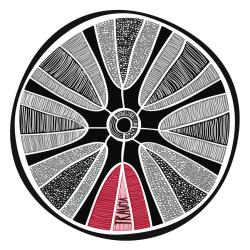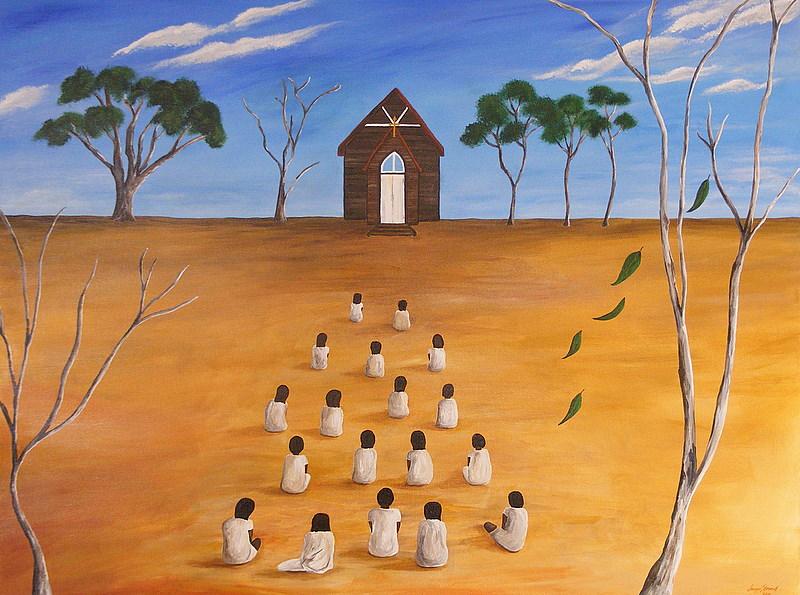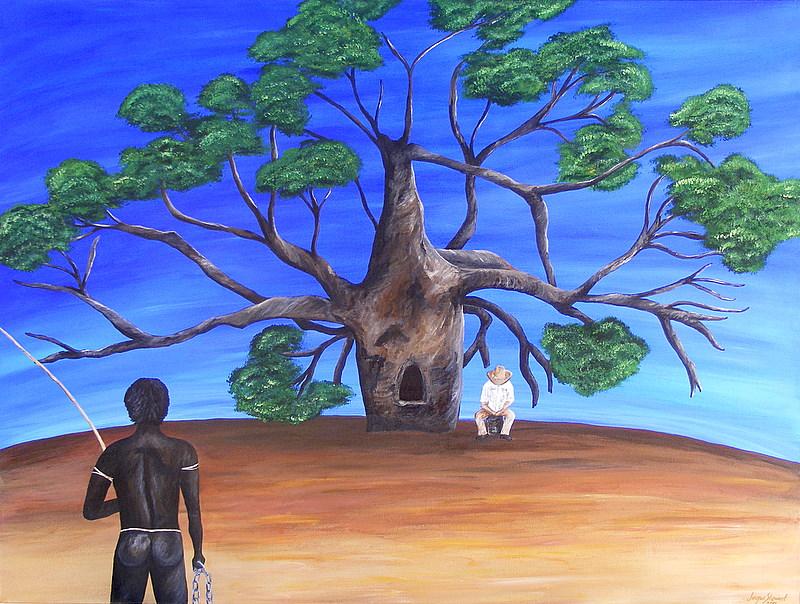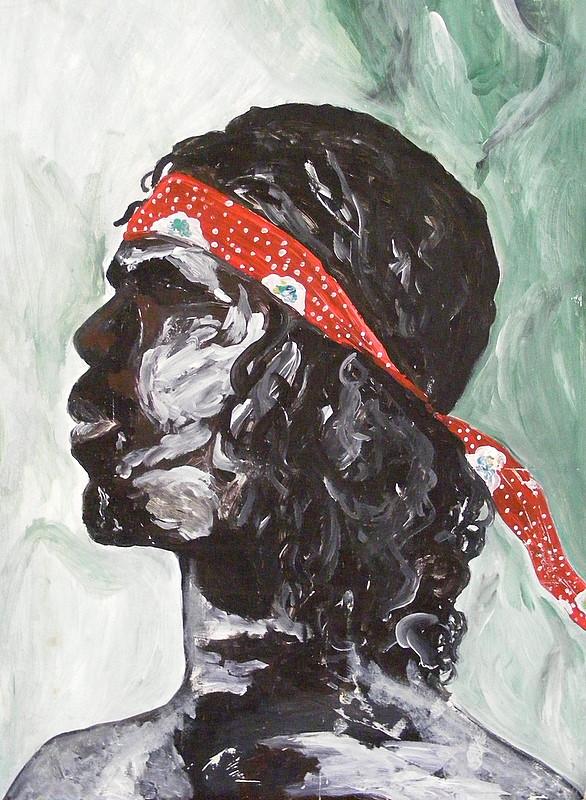Transgenerational trauma

Artwork by Lucy Simpson, Gaawaa Miyay Designs, gaawaamiyay.co.
Grief and loss
Grief and loss issues are prevalent in many Indigenous families and communities and continue to adversely impact the lives of many people. These grief and loss issues are a combination of past and ongoing colonisation resulting in the forced removal of children and other underlying socio-economic factors. The path of destruction is cyclical and inter-generational.
"Loss of land is a potent background to understanding trauma and its intergenerational effects for Aboriginal people, for it impacted on their well-being and has continued to do so in many ways." Beverley Raphael, Patricia Swan and Nada Martinek [1]
Grief and loss issues can result in:
- mental health issues
- self-harm and intentional injury
- suicide — particularly with youth
- drug and alcohol misuse and addiction
- over-representation in the juvenile and criminal justice system
- over-representation in welfare systems
- homelessness
- family and domestic violence
- general feeling of hopelessness
- relationship/connection breakdown
- loss of country
- loss of identity
Ongoing impact of historical abuse and trauma
Although experiences of trauma and loss are not necessarily causes of mental illness, unresolved emotional distress or overwhelming grief can lead to poor mental health. A history of invasion, the ongoing impact of colonisation, loss of land and culture, racism within the wider Australian community, family separations – through, for instance, the Stolen Generations – and deaths in custody, are all examples of trauma and loss experienced by Aboriginal people that contribute to mental distress.
"The past has an influence and that it’s been passed down generationally and that the effects of colonisation and the stolen generations in and with that generation and even though we may not, technically, be having people being stolen now, we still have the impact of that … that we’re living with now and into the future unless that cycle’s broken." Shane Merritt [2]
Historical abuse and trauma is defined as the subjective experiencing and remembering of events in the mind of an individual or the life of a community, passed from adults to children in cyclic processes as ‘collective emotional and psychological injury … over the life span and across generations’ (Muid, 2006, p. 36) and has been well researched.
For instance, the Victorian Indigenous Family Violence Taskforce Final Report (2003) acknowledged inherited grief and trauma, drug abuse and the effects of institutionalism and child removal policies as contributing factors. In addition, the Western Australian Child Health Survey (2005) highlighted the intergenerational effect of forcible removal for carers and children of carers as experiencing a higher risk of emotional and behavioural problems, overuse of alcohol and more likely to be charged with an offence at some time in their lives.
Past trauma or loss can affect current experiences
Current experiences of trauma or loss can also be affected by the person’s past experiences of trauma or loss. For instance, where death, separation and loss are more frequent, a person may find it increasingly difficult to deal with each individual event. If a person has experienced a loss or traumatic event, even if it was a very long time ago, unresolved emotional distress can still affect a person’s life. Some people may become suicidal.
Aboriginal communities are highly integrated and bereavement and traumatic events often have a widespread and devastating impact on health and community stability, even when only a few people are the primary victims.
There were 996 suicide deaths registered across Australia between 2001 and 2010 where the deceased person was identified as being of Aboriginal or Torres Strait Islander origin. This represented approximately 5% of all suicide deaths registered in this period. Suicides accounted for 4.2% of all registered deaths of people identified as Aboriginal and Torres Strait Islander in 2010, compared with 1.6% for all Australians. In the Aboriginal and Torres Strait Islander population, the highest age-specific rate of suicide was among males between 25 and 29 years of age (90.8 deaths per 100,000 population) [3].
Chapter References
[1] Intergenerational Aspects of Trauma for Australian Aboriginal People, from International Handbook of Multigenerational Legacies of Trauma, edited by Yael Danieli. Plenum Press, New York, 1998.
[2] Shane Merritt, University of New England, Transgenerational trauma (2009).
[3] Australian Bureau of Statistics, 3309.0 – Suicides, Australia, 2010.
Artwork
The cumulative losses incurred by Aboriginal people due to colonisation has caused ongoing grief and trauma. These losses have manifested in high rates of poor mental health, increased incarceration, substance abuse and family breakdown. Transgenerational trauma is exposed by Aboriginal artists who portray the daily realities of some people’s lives. For example Nyree Reynolds work ‘Until next time’ is a poignant depiction of visiting multiple family members in prison. In text she includes with the painting, Nyree comments on the lack of support and strategies to prevent her people from reoffending and being incarcerated multiple times.
UTS ART Education and Outreach Co-ordinator Alice McAuliffe and academic Jennifer Newman have produced a series of videos that explore the cultural and social contexts of Indigenous artwork from the UTS Art collection.
‘Up in the Sky’ by Tracey Moffatt
Tracey Moffatt’s Up in the Sky series is comprised of 25 offset prints. The images use amateur actors in baron, forlorn settings. They have a distinctly Australian feel and the interactions between black and white characters, implies a commentary on Australian race relations between Indigenous and non Indigenous people. Each image looks like a still from a completed film or a documentary we are unable to see in full. The images that Moffatt shows us imply a story, rather than tell a story, leaving the gaps to be filled by our own knowledge and histories.

Hope Beyond the Window : a Stolen Generation by Jacqui Stewart. Image provided by the artist. jacquistewart.com.au

Prison Boab tree: chainless by Jacqui Stewart. Image provided by the artist. jacquistewart.com.au

Indigenous Man by Jacqui Stewart. Image provided by the artist. jacquistewart.com.au
